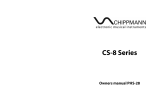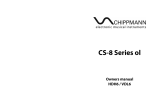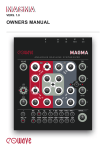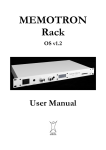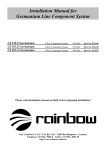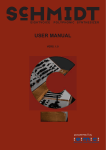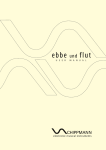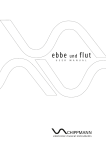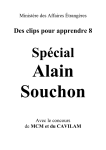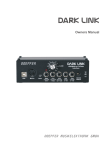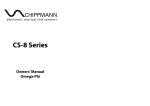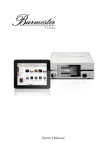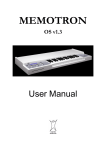Download Owners manual
Transcript
CS-8 Series Owners manual VCF02 CS-8 Series VCF02 Rev1.0, May 2012 User manual by Carsten Schippmann Graphic design CS-8 Series: Carsten Schippmann Concept and development: Carsten Schippmann English translation by Matthias Fuchs, Stephen Parsick Contact: Schippmann electronic musical instruments Dipl.-Ing. Carsten Schippmann Wilhelm-Kabus-Str.46 D-10829 Berlin Web: www.schippmann-music.com Email: [email protected] The manufacturer Schippmann electronic musical instruments is constantly striving for improvements and developments of their products. Therefore, we reserve the right to change technical specifications which improve our products at any time without notice. This includes the look of the unit which might differ from pictures in this manual. No part of this publication is to be reproduced, transmitted, transcribed or translated in any form or by any means whatsoever without written permission by Schippmann electronic musical instruments. 2012, Schippmann electronic musical instruments, errors excepted, subject to change without prior notice. -1- CS-8 Series VCF02 Rev1.0, May 2012 PREFACE First of all, congratulations on the purchase of this 3U Eurorack synthesizer module. This manual contains a condensed description of the functionality and addresses users with a certain level of elementary technical knowledge. The CS-8 VCF02 is a very versatile, fully analogue, programmable and voltagecontrolled filter (VCF). It is capable of processing all sorts of audio signals. It is designed for mounting into a 3U Eurorack with an internal +/- 12V power supply. This module is capable of producing 121 different filter types (27 low-pass, 18 high-pass, 13 band-pass, and 63 all-pass/notch/phase-type filters). External control voltages can be used to control all functions, thus the CS-8 VCF02 can be remote-controlled by sequencers, foot pedals/switches etc. The CS-8 VCF02 features some unique and very powerful functions that are entirely new to voltage-controlled filter modules such as emphasize, 2nd harmonic distortion, and drop. The CS-8 VCF02 features a unique “layer cake” design. This way, its installation depth is reduced to a minimum, compared to other Eurorack modules. Design and implementation meet highest technical standards concerning usability, sound quality, and signal-to-noise ratio. The front panel is made from an anodised and printed piece of aluminium sheet metal of 2 mm gauge. The entire design and production work was done in Germany. -2- CS-8 Series VCF02 Rev1.0, May 2012 1. WARRANTY......................................................................................................................... 4 1.1 Limited Warranty.................................................................................................... 4 1.2 Terms of Warranty ................................................................................................. 4 1.3 Warranty transferability...................................................................................... 4 1.4 Claim for damages ................................................................................................. 4 2. CE AND FCC COMPLIANCE STATEMENTS .............................................................. 5 3. DISPOSAL............................................................................................................................ 5 4. SAFETY INSTRUCTIONS................................................................................................. 5 5. MAINTAINANCE/ CLEANING ....................................................................................... 6 6. GETTING STARTET........................................................................................................... 7 6.1 Unpacking.................................................................................................................. 7 6.2 Installation ................................................................................................................ 7 7. CONTROLS .......................................................................................................................... 7 7.1 Front panel ................................................................................................................ 7 7.2 Back ............................................................................................................................11 7.3 Initial operation ....................................................................................................12 7.4 Calibration...............................................................................................................12 8. MODULE DESCRIPTION...............................................................................................13 8.1. Layout and functions.........................................................................................13 8.2. Filter types .............................................................................................................21 9. TECHNICAL DATA AND SIGNAL VALUES .............................................................27 9.1 Technical Data (in general)...............................................................................27 9.2 Signals and threshold values ..........................................................................27 -3- CS-8 Series VCF02 Rev1.0, May 2012 1. WARRANTY 1.1 Limited Warranty Schippmann electronic musical instruments warrants the mechanical and electronic components of this product for a period of two (2) years from the original date of purchase, according to the warranty regulations described below. If the product exhibits any faults within the specified warranty period that are not excluded from this warranty, Schippmann electronic musical instruments shall, at its discretion, either replace or repair the product. This warranty exists in addition to the general terms of business of the manufacturer Schippmann electronic musical instruments. 1.2 Terms of Warranty Schippmann electronic musical instruments reserves the right to execute warranty services only if the product comes with a copy of the dealer’s original invoice. Final discretion of warranty coverage lies solely with Schippmann electronic musical instruments. Any Schippmann electronic musical instruments product deemed eligible for repair or replacement under the terms of this warranty will be repaired or replaced within 30 days after receiving the product at Schippmann electronic musical instruments. Damages or defects caused by improper handling or opening of the unit by unauthorized personnel (user included) are not covered by this warranty. Products which do not meet the terms of this warranty will be repaired exclusively at the buyer´s expense and returned C.O.D. with an invoice for labour, materials, return shipping, and insurance. Products repaired under warranty will be returned with shipping prepaid by Schippmann electronic musical instruments. Outside Germany, products will be returned at the buyer´s expense. 1.3 Warranty transferability This warranty is extended to the original purchaser and cannot be transferred. No other person (retail dealer, etc) shall be entitled to give any warranty promise on behalf of Schippmann electronic musical instruments. 1.4 Claim for damages Schippmann electronic musical instruments does not accept claims for damages of any kind, especially consequential loss or damage, direct or indirect of any kind however caused. Liability is limited to the value of this product. The -4- CS-8 Series VCF02 Rev1.0, May 2012 general terms of business drawn up by Schippmann electronic musical instruments apply at all times. Please note: The controls and switches, especially the Freq (cutofffrequency) or Reso (resonance) controls are programming facilities, no realtime controllers! Tweak them carefully since we cannot be held liable for “abused” potentiometers and switches. 2. CE AND FCC COMPLIANCE STATEMENTS This device has been tested and deemed to comply with the DIN EN 60065 standards. This device has been tested and deemed to comply with the requirements, listed in FCC Regulations, part 15. The device complies with EN 55103-1 and EN 55103-2 standards. Because of the entirely analogue construction, this device does not generate radio frequencies and will not interfere with radio frequencies generated by other electronic devices. 3. DISPOSAL This device has been manufactured to RoHS-standards, in compliance with the requirements of the European parliament and council and is thus free of lead, mercury, and cadmium. !! Notice: This product is still special waste and is not to be disposed of through regular household waste !! For disposal, please contact your local dealer or Schippmann electronic musical instruments 4. SAFETY INSTRUCTIONS BEFORE USING THIS PRODUCT FOR THE FIRST TIME, PLEASE READ THE ENTIRE USER MANUAL THOROUGHLY. -5- CS-8 Series VCF02 Rev1.0, May 2012 • • • • • • • • • • • • • • PLEASE AVOID SHARP BENDING OF ANY CORDS AND CABLES. CORDS SHOULD NOT BE INSTALLED WITHIN THE REACH OF CHILDREN OR PETS. DO NOT TREAD THE ENCLOSURE OF THE PRODUCT, DO NOT PLACE HEAVY OBJECTS ON IT. BEFORE REMOVING THE PRODUCT FROM THE RACK, PLEASE DISCONNECT THE POWER PLUG AND ALL OTHER CABLE CONNECTIONS. PLEASE DISCONNECT THE POWER PLUG FROM THE OUTLET IN CASE OF A THUNDERSTORM. NEVER OPEN THE ENCLOSURE OF THE PRODUCT! NEVER TRY TO MODIFY THE INTERNAL CIRCUITRY! ONLY QUALIFIED SERVICE PERSONNEL IS ALLOWED TO OPEN THE ENCLOSURE. DO NOT PLACE OPEN FIRE ON TOP OF THE PRODUCT (CANDLES, ASH TRAYS, HOT THAI CURRIES ETC). NEVER EXPOSE THE PRODUCT TO WATER, BEER, OR MOISTURE. ADULTS ARE TO MAKE SURE THAT CHILDREN FOLLOW ALL SAFETY INSTRUCTIONS. SAME THING GOES FOR PETS. AVOID MECHANICAL STRESS OR IMPACT. DO NOT DROP THE PRODUCT; EVEN IF THERE IS A CONTROL LABELLED "DROP"!. DO NOT USE THE PRODUCT WITH TOO MANY OTHER ELECTRONIC DEVICES RUNNING FROM ONE SINGLE OUTLET, ESPECIALLY IN CONNECTION WITH EXTENSION CORDS. DO NOT ATTEMPT TO SAVE MONEY ON CHEAP SOLUTIONS. BUY PROPER HIGH-DUTY POWER DISTRIBUTORS AND CORDS! NEVER USE EXTENSION CORDS WITH LESS MAXIMUM LOAD THAN THE TOTAL POWER CONSUMPTION OF ALL DEVICES CONNECTED TO A SINGLE POWER OUTLET COMBINED. OVERLOADING EXTENSION CORDS CAN CAUSE FIRE. AVOID MECHANICAL STRESS ON SOCKETS AND KNOBS / SWITCHES. PROTECT YOUR SPEAKERS AND EARS (!) AGAINST EXCESSIVE AUDIO LEVELS. THE CS-8 VCF02 UNIT IS CAPABLE OF GENERATING EXTREMELY LOW AS WELL AS EXTREMELY HIGH FREQUENCIES. BOTH MIGHT CAUSE SERIOUS DAMAGE TO AUDIO EQUIPMENT AND EARDRUMS! 5. MAINTAINANCE/ CLEANING • BEFORE CLEANING THE PRODUCT, PLEASE DISCONNECT THE POWER -6- CS-8 Series VCF02 Rev1.0, May 2012 • PLUG FROM THE OUTLET OR DISCONNECT THE MODULE FROM ITS POWER CONNECTOR BY PULLING THE FLAT RIBBON CABLE. USE A DRY OR SLIGHTLY MOIST CLOTH OR COMPRESSED AIR FOR CLEANING. NEVER USE ANY CLEANER OR THINNER (E.G. PAINT THINNER OR ACETON). PRINTS AND PAINTWORK WILL IMEDIATELY BE DESTROYED!! ALSO AVOID ALCOHOL (ISOPROPYLIC), GAS, SPIRITS (SCOTCH SINGLE MALTS, FOR A START) OR ABRASIVE HOUSEHOLD CLEANERS! 6. GETTING STARTET 6.1 Unpacking The box should contain the following items: - 1 x CS-8 VCF02 3HU rack-mount module - 1 x Ribbon cable (20 cm length with two 16 pole IDC-connectors) - 4 x M3 screws - 4 x polypropylene washers - This owners’ manual If the content of the box turns out to be incomplete, please get in touch with your dealer or Schippmann electronic musical instruments immediately. In case of damage caused in transit, please get back to the responsible carrier and Schippmann electronic musical instruments immediately. We will support you in this case. 6.2 Installation Place the unit on a clean, dry and sturdy surface, or use a suitable keyboard stand or 19” rack. For 19” rack mounting, a suitable rack (3U Eurorack with +/12V power supply rails) is required. The CS-8 VCF02 uses discrete all-analogue electronics. Thus certain parameters, such as Resonance and Emphasize, may be temperature-sensitive. We recommend placing the CS-08 VCF02 away from heat sources such as radiators, lamps or other units that produce heat (e.g. power amps or internal power supplies). 7. CONTROLS 7.1 Front panel -7- CS-8 Series VCF02 Rev1.0, May 2012 Fig. 1 shows the front panel with consecutively numbered controls and sockets. 11 12 13 14 15 16 17 18 19 20 21 10 9 22 8 7 6 23 24 5 4 3 2 1 25 26 27 28 40 39 38 37 36 35 34 33 32 31 30 29 Fig. 1 1. 2. 3. 4. 5. ALL button – activates the all-pass function (blue LED lights up) BP6 button – activates the 6 dB band-pass non-inverted or inverted function (LED lights up green = non-inverted, red = inverted) LP12 button – activates the 12 dB low-pass non-inverted or inverted function (LED lights up green = non-inverted, red = inverted) BP18 button – activates the 18 dB band-pass non-inverted or inverted function (LED lights up green = non-inverted, red = inverted) LP24 button – activates the 24 dB low-pass non-inverted or inverted -8- CS-8 Series VCF02 Rev1.0, May 2012 6. 7. 8. 9. 10. 11. 12. 13. 14. 15. 16. 17. 18. 19. 20. 21. 22. 23. function (LED lights up green = non-inverted, red = inverted) Gain switch – 0 dB/+20 dB boost of audio Input1 drive LED – lights up red at approx. 2 vpp (peak-to-peak) audio level (sum of input 1 and input 2) and increases its brightness at higher input levels. High levels overdrive the filter circuitry and produce non linear performance with interesting sonic results. Input1 control – attenuates the incoming audio signal at Input1 socket between -∞ dB and 0 dB Phase reverse switch – 0°/180° inverts (180°) (0 is no inversion) the incoming audio signal at Input2 socket Input2 control – attenuates the incoming audio signal at Input1 socket between -∞ dB and 0 dB CV1 control – adjusts scaling of the FM control voltage applied to CV1 socket (CV = control voltage) between 0 Oct./V and 3.6 Oct./V Phase reverse switch – 0°/180° inverts (180°) (0 is no inversion) the incoming CV-signal applied to CV1 socket CV2 control – adjusts scaling of the FM control voltage applied to CV2 socket (CV = control voltage) between 0 Oct./V and 3.6 Oct./V Phase reverse switch – 0°/180° inverts (180°) (0 is no inversion) the incoming CV-signal applied to CV2 socket Freq control – adjusts the cut-off / centre frequency of the filter between 2 Hz und 35 kHz CV-Res control – adjusts scaling of the resonance control voltage applied to Reso CV socket between 0 resonance/Volt and self-oscillation/5 Volt Phase reverse switch – 0°/180° inverts (180°) (0 is no inversion) the incoming CV-signal applied to Reso CV socket Reso control – adjusts the resonance of the filter (Q-factor) between 0 (1) and self-oscillation (∞) Emph control – adjusts the emphasis of resonance and thus controls the level of the self-oscillation between 0.05 (weak emphasis/low selfoscillation level) and 1 (strong emphasis/high self-oscillation level) on LED – indicates the activity of the Drop control; lights up when lowpass functions are active Drop control – controls the loss of signal level (Drop) below the cut-off frequency (resp. passed through frequency range) when resonance increases. Range between -12 dB and 0 dB; only active at low-pass settings (LED lights up yellow) Gain control – adjusts the output gain of the filter between -20 dB and 0 dB clip LED – lights up when filter output is clipping (results in hard -9- CS-8 Series VCF02 Rev1.0, May 2012 distortion) 24. 2nd Harm button – adds soft harmonic distortion (2nd harmonic) to the output signal, increasing at higher resonance levels; lights up red when active 25. Output socket – provides the filtered output signal 26. Emph 0-5 V CV socket (input) – modulation input to control the Emphasize parameter; accepts -5 V - +5 VDC; applied CV is added to the current parameter/knob setting 27. Reso 0-5 V CV socket (input) – modulation input to control the resonance parameter; applied CV of +5VDC and control 18 (Reso) = 0 measures up with resonance at maximum; resp. an attached CV of -5VDC results in a resonance of “0” when control 18 (Reso) is set to 10 28. Reso CV socket (input) – DC-CV-input routes the applied modulation signal to the CV-Res control 29. 2nd H socket (input) – an applied CV switches the function 2nd Harm to “on” (≥+3 V) or “off” (≤+2 V); the LED of the button shows current setting; when plugged in, the corresponding button is not active 30. ALL socket (input) – an applied CV switches the filter function ALL to “on” (≥+3 V) or “off” (≤+2 V); the LED of the button shows current setting; when plugged in, the corresponding button is not active 31. BP6 socket (input) – an attached CV switches the filter function BP6 to “non-inverted” (≥+1 V), “inverted” (≥+3 V) or “off” (<+1); the LED of the button shows current setting; when plugged in, the corresponding button is not active 32. LP12 socket (input) – an attached CV switches the filter function LP12 to “non-inverted” (≥+1 V), “inverted” (≥+3 V) or “off” (<+1); the LED of the button shows current setting; when plugged in, the corresponding button is not active 33. BP18 socket (input) – an attached CV switches the filter function BP18 to “non-inverted” (≥+1 V), “inverted” (≥+3 V) or “off” (<+1); the LED of the button shows current setting; when plugged in, the corresponding button is not active 34. LP24 socket (input) – an attached CV switches the filter function LP24 to “non-inverted” (≥+1 V), “inverted” (≥+3 V) or “off” (<+1); the LED of the button shows current setting; when plugged in, the corresponding button is not active Sockets 29 – 34 accept AC voltages covering the entire audio range! 35. 1 V/Oct socket (input) – calibrated CV-input for cut off / centre frequency control; scaling is 1V/octave -10- CS-8 Series VCF02 Rev1.0, May 2012 36. CV2 socket (input) – DC-CV-input routes the applied modulation signal to the CV2 control 37. 0.5 V/Oct socket (input) – non-calibrated CV-input for cut off / centre frequency control; scaling is 0.5V/octave 38. CV1 socket (input) – DC-CV-input routes the applied modulation signal to the CV1 control 39. Input2 socket (input) – (AC) audio input routes the applied audio signal to the Input2 control 40. Input1 socket (input) – (AC) audio input routes the applied audio signal to the Input1 control 7.2 Back Fig. 2 shows the back of the module with consecutively numbered elements. Fig. 2 -11- CS-8 Series VCF02 Rev1.0, May 2012 1. 2. 3. 4. 5. 6. 7. 8. Filter module – contains the core of the filter circuitry Reso trimmer P6 – calibration of zero resonance point Emphasize feed-through trimmer P5 – calibration of the emphasize modulation-signal feed-through to the audio output (→ no feed-through) Resonance feed-through trimmer P4 – calibration of the resonance modulation-signal feed-through to the audio output (→ no feed-through) Output offset trimmer P7 – calibration of audio output DC-offset (→ 0 V) Cut-off/ centre frequency offset trimmer P2 – calibration of cut-off /centre frequency (→ 35 kHz@Freq Pot.(15) fully clockwise) 1 V/Oct scaling trimmer P1 – calibration of CV-scaling at socket 35 (→ 1V/oct) 16 Pin power cable connector 7.3 Initial operation The power connector’s (8) pin-out in top view (refer to fig. 2) is assigned as follows: Bottom to top, left to right. Thus pin 1 is located at bottom left, pin 2 above pin 1 etc. Pin 15 is at bottom right, pin 16 at top right. Pin 1, 2 = -12 V (labelled with a triangle) Pin 3-8 = GND (ground, 0 V), located outward on all sockets Pin 9, 10 = +12 V Pin 11-16 = not in use To hook up power to the module, connect one of the IDC-sockets of the included flat ribbon cable to the connector (refer to fig. 2). Observe guide key for the polarity of the connector in order to avoid pin reversal. The red tag of the cable is to match the triangle-label. 7.4 Calibration All trimmers are 12 gauge trimmers, i. e., 12 turns are needed to cover the entire range. Trimmers P2, P6 and P7 increase their parameters when turned clockwise. Trimmer P1 increases the sensitivity when turned clockwise, meaning the control voltage variation that is required to cover a one-octave range is reduced. Trimmers P4 and P5 should better be left untouched. -12- CS-8 Series VCF02 Rev1.0, May 2012 Needless to say that the module VCF02 is delivered perfectly calibrated! (but we thought we´d point that out anyway) 8. MODULE DESCRIPTION 8.1. Layout and functions Fig. 3 shows the layout of the VCF02 module: -13- 0°/180° -1 -1 0°/180° Amp 0/+20 db Fig. 3 -14- LP24 drive (red) Σ 0.5 V/Oct LP24 logic 1 V/Oct grn/ red BP18 INPUT 0°/180° Input2 CV2 BP18 logic FREQ 0°/180° grn/ red LP12 Freq LP12 logic RESO -1 Input1 CV1 grn/ red BP6 VCF Reso CV BP6 logic Reso 0-5 V Emph ALL logic EMPH grn/ red ALL Reso -1 2nd H logic Output 2nd H blue Drop Drop 0-5 V Emph red clip (red) Output Gain on (yel) CS-8 Series VCF02 Rev1.0, May 2012 CS-8 Series VCF02 Rev1.0, May 2012 INPUT: The audio inputs are labelled Input1 and Input2. They are true ACinputs. Both controls Input1 and Input2 are decoupled by means of a capacitor and directly connected to their input sockets. They simply attenuate the signal between the factor 0 and 1. Input1 switch provides a signal boost of 0 dB resp. +20 dB. Input2 switch provides a phase shift of 0° (no shift) or 180° (phase inversion). Output: Output is a DC-output. After some operation time, a certain voltage offset might build up. It can be reset to zero (0V) by trimmer P7, located at the back of the module. drive-LED: The drive-LED lights up at signal levels of 2 vpp (volts peak-topeak) and higher, applied to the VCF INPUT. At higher levels, the LED lights brighter. There is no clipping produced but a non-linear distortion softly coming in. FREQ: Several factors influence the VCF-parameter FREQ, known as cut-off frequency (fc) or resonance frequency. The cut-off frequency defines the frequency at which the high and low-pass filters start to attenuate the signal and band-pass filters have their maximum peak (centre frequency). Around the cut-off/resonance frequency, the signal is also emphasized, which leads to more sound coloration up to self-oscillation of the filter. The Freq knob covers a parameter range of 2 Hz to 35 kHz. External control provides a maximum range of 40 kHz and virtually no limits at the low range (e.g. 0.1 Hz). Fig. 4 shows the four basic types of filter characteristics and their cut-off frequency (resonance frequency) curves. -15- CS-8 Series VCF02 Rev1.0, May 2012 Level [dB] Level [dB] Resonance frequency / cutoff-freq. (fc) Resonance frequency / cutoff-freq. (fc) ∆ freq. ∆ dB Slope [db/Octave] High-pass function Low-pass function Signal frequency Signal frequency Level [dB] Level [dB] Resonance frequency / center-freq. (fc) Resonance frequency / Notch-freq. (fc) Band-pass function Notch function Signal frequency Signal frequency Fig. 4 Control voltage inputs are CV1, CV2, 0.5V/Oct and 1V/Oct. Both control s CV1 and CV2 are directly connected to their input sockets. They simply attenuate the signal between the factor 0 and 1. The corresponding switches provide a phase shift of 0° (no shift) or 180° (phase inversion) of the applied modulation signal. RESO: The factors that influence the filter parameter RESO also have an effect on its self-resonance. At higher resonance settings, frequencies around the cut-off/centre frequency are emphasized more than others, which produces a resonant peak. -16- CS-8 Series VCF02 Rev1.0, May 2012 The Reso control controls this boost from “0” (no resonance) to “10” (selfoscillation). The starting point of the self-oscillation depends a bit on the Emph parameter setting (see below). It will start approx. at settings of Reso = 6 (if Emph = 1) and 8 (if Emph = 0.3). Fig. 5 shows the effect of the Resonance and Drop parameters of a low-pass filter. Level [dB] Level [dB] fc fc emergence of a resonance peak resonance drop / gain loss Low-pass function Low-pass function Signal frequency Signal frequency Fig. 5 The corresponding control voltage inputs are CV-Res and Reso 0-5 V. The CVRes control is directly connected to the input socket. It simply attenuates the signal between the factor 0 and 1. The corresponding switch provides a phase shift of 0° (no shift) or 180° (phase inversion) of the modulation signal applied to Reso CV. EMPH: This function is really unique! It allows for control of the level of emphasis, independent from the strength of the resonance setting! Thanks to this, the tone produced by the self-oscillating filter will not necessarily have a high level, which makes it much easier to handle within a musical or timbral context. Use low Emph values (Emph = 0.05 – 0.1) and the filter will oscillate only slightly, use high values (Emph = 0.5 – 1) and the filter’s self-oscillation will produce very high output levels – just as you may know from any other synthesizer filter. Fig. 6 will help to explain this feature in a bit more detailed way. -17- CS-8 Series VCF02 Rev1.0, May 2012 Level [dB] Level [dB] fc low Emph-values fc start of self-oscillation start of self-oscillation high Emph-values Low-pass function Low-pass function Signal frequency Signal frequency Fig. 6 Please note: Some other manufacturers use the term “emphasis” to describe the parameter that we call “resonance”. On your CS8, emphasis has a completely different meaning. Please make sure not to mix up these terms. The control voltage input labelled 0-5 V Emph can be used to control the entire parameter range. Drop: This function is also pretty unique. You will love it since it very effectively compensates a phenomenon that is not only common on most synthesizer filters, but also unwanted at that: With low-pass filters, the level of the signal passed through usually drops significantly when increasing resonance – resulting in a weak-sounding bottom end. On the CS8, you can work against this effect by using the Drop control. It adjusts the boost of the signal passed through between -12 dB and 0 dB (also see fig. 5 top). The Drop-function is only available in low-pass modes! Note 1: The more you turn up the Drop control, the more the filter input will be overloaded. Sometimes, these resulting saturation effects may be desired, sometimes not. A good compromise between effective level compensation and low saturation effects are Drop-settings between -3 dB and -6 dB. Experiment and go from there. Note 2: The Drop compensation only works with low-pass settings. -18- CS-8 Series VCF02 Rev1.0, May 2012 Unfortunately, there is no way of getting round this fact, regardless of any design tricks. If you happen to come across one, please feel free to share yourself with us. Eternal praise will be yours. on-LED: The activated Drop function is indicated by the lit yellow LED. At the same time, it shows an active low-pass setting. Gain: The Gain control adjusts the output boost of the filter or, in other words, the level ratio between output and VCF-INPUT (sum of input 1 and input 2). The range is between -20 dB and 0 dB. Use the Gain control to reduce the output level in order to avoid undesired clipping (watch clip-LED). The filter output signal can be tapped from the output socket. 2nd Harm-button: As you may have noticed already, your CS8 sports some pretty unique features – the 2nd Harm button is one of them. It generates a soft distortion in the filter output which emphases the 2nd harmonic (overtone), resulting in a subtle, “warm”-sounding coloration. When activated, the button lights up red. The corresponding control input 2nd H (29) allows for a remote control of this function. Plugging in a cable will render the button inactive, but the LED will still show the status of the function. The input accepts a DC-voltage of -12 V - +12 V as well as audio signals of any frequency. The function is activated at a voltage of +3 V (or higher) and is disabled at +2 V (or lower) (hysteresis). Slope: This function selects the different filter types (low, high, band-pass etc.). They can be selected by using the five buttons labelled LP24, BP18, LP12, BP6 and ALL. Their respective function is described in the following section. ALL-button: This special filter function passes all frequencies to the filter output. It lights up blue when active. The corresponding control input (ALL) allows for remote control of this function. Plugging in a cable renders the button inactive, but the LED still shows the status of the function. The input accepts a DC-voltage of -12 V - +12 V as well as audio signals of any frequency. The function is activated at a voltage of +3 V (or higher) and is disabled at +2 V (or lower) (hysteresis). BP6-button: This filter function activates a band-pass type. It attenuates frequencies above and below the centre frequency (or resonance frequency) at a slope of 6 dB/octave. -19- CS-8 Series VCF02 Rev1.0, May 2012 LP12-button: This filter function activates a low-pass type. It attenuates frequencies above the cut-off frequency (or resonance frequency) at a slope of 12 dB/octave. BP18-button: This filter function activates a band-pass type. It attenuates frequencies above the centre frequency (or resonance frequency) at a slope of 18 dB/octave and below at 6 dB/octave. LP24-button: This filter function activates a classic low-pass type. It attenuates frequencies above the cut-off frequency (or resonance frequency) at a slope of 24 dB/octave. The four buttons labelled LP24, BP18, LP12, BP6, as well as the previously mentioned ALL-function, work like this: Their respective function (e.g. BP18) is added or subtracted to/from the filter output, depending on the setting which is indicated by its LED-colour. Hit each button repeatedly and it will change off-green-red-off-green-red-…etc. Green means that the selected filter function works with a positive algebraic sign (addition), red means a negative algebraic sign (subtraction) and – you guessed it – off means that the function is not active. By combining these settings (more on this below), you can create up to 121 different filter types, which truly gives a new dimension to the term “multimode filter”! The five corresponding control voltage inputs allow for remote control of these functions. As soon as a cable is plugged in, the corresponding button will no longer be active, but its LED will still be working, showing the current setting. These inputs work at positive DC-voltage from 0V to +12V. Negative voltages may cause unpredictable behaviour but will not cause any detrimental effects or electronic damage. 0 V to +1V >+1 V to +3V >+3V (ideal: 0 V) (ideal: 2 to 2.5 V) (ideal: 4 to 5 V) → setting: off → setting: green (+) → setting: red (-) The five filter functions LP24, BP18, LP12, BP6 and ALL are combined according to their algebraic sign and define the resulting behaviour of the filter. Example: If button ALL lights “blue”, BP18 “green”, LP24 “red” and all others are off, the output signal will behave like this: -20- CS-8 Series VCF02 Rev1.0, May 2012 Output = ALL + BP18 – LP24 (resulting in a high-pass filter) 8.2. Filter types In the following section you will find some basic rules that will help you create various sorts of filter types. Band-pass filters: A band-pass filter lets a band around the centre/resonance frequency pass. Frequencies above and below are attenuated (see fig. 4). The following combinations will result in a band-pass setting: 1. ALL always inactive 2. BP6 and BP18 any – since they are band-pass filters in itself, all combinations of them will also result in more band-pass filters. 3. LP12 and LP24 – both have to be activated but with opposite algebraic signs, either a.) +LP12(green)–LP24(red) (band-pass in-phase) or b.) -LP12(red)+LP24(green) (band-pass out-of-phase by 180° for all frequencies) Initially this results in 26 band-pass combinations in total [3 (BP6) x 3 (BP18) x 3 (LP12/24 combinations) – 1(all off)], each of them in-phase and phase-inverted. Since the characteristics stay the same, we have 13 different band-pass functions. High-pass filters: A high-pass lets the frequencies above the cut-off/resonance frequency pass. Frequencies below are attenuated (see fig. 4). The following combinations will result in a high-pass setting: -21- CS-8 Series VCF02 Rev1.0, May 2012 1. ALL always active 2. either a.) –LP12(red) (LP24 disabled) or b.) –LP24(red) (LP12 disabled) 3. BP6 and BP18 any Subtraction of one low-pass (LP12 or LP24) produces a high-pass. This means 18 different high-pass combinations in total [3 (BP6) x 3 (BP18) x 2 (LP12/24 combinations)]. Low-pass filters: A low-pass lets the frequencies below the cut-off/resonance frequency pass. Frequencies above are attenuated (see fig. 4). The following combinations will result in a low-pass setting: 1. ALL always inactive 2. BP6 and BP18 any 3. At least one LP-function active a.) LP12 and LP24 should not have different algebraic signs, therefore no settings like (+LP12(green)-LP24(red) or -LP12(red)+LP24(green)), since this would result in a band-pass (see above). LP12 and LP24 with the same algebraic sign generate a signal boost of +6 dB (addition of two low-passes). Simple maths. Initially, this results in 54 low-pass combinations in total [3 (BP6) x 3 (BP18) x 6 (LP12/24 combinations), each of them in-phase and phase-inverted. Since the characteristics stay the same, we have 27 different low-pass functions altogether. All-pass/notch/phase shifter: -22- CS-8 Series VCF02 Rev1.0, May 2012 These filter types pass all frequencies but alter the phase of the signal. Some of them, e.g. notch types, generate phase cancellations at certain frequencies (see fig. 4). 1. ALL always active 2. BP6 and BP18 any 3. More than one LP-function has to be “negative” (red LED, “–“). If not, the setting will generate a high-pass function. a.) +LP12(green)–LP24(red) OR -LP12(red)+LP24(green) generate a signal boost with factor 1 (0 dB) from input to output. b.) +LP12(green) OR +LP24(green) generate a signal boost of factor 2 (+6 dB) on signals below the cut-off/resonance frequency. c.) +LP12(green)+LP24(green) generates a signal boost of factor 3 (+9.5 dB) on signals below the cut-off/resonance frequency. d.) -LP12(red)-LP24(red) generates a phase shift of 180° (inversion) on signals below the cut-off/resonance frequency. This results in 63 different combinations in total [3 (BP6) x 3 (BP18) x 7 (LP12/24 combinations)]. -23- CS-8 Series VCF02 Rev1.0, May 2012 Summery of filter type rules: ALL active (blue) → high-passes: just one LP(12 or 24) active red (-) BP6/BP18 any → all-passes: any other ALL inactive (off) → band-passes: BP6/BP18 any LP12 and LP24 both off or both at once active with subtended algebraic signs (LP12/24 = green/red or = red/green) → low-passes: at least one LP active (though not as the band-pass setting) BP6/BP18 any The following chart (c. 1) shows a selection of filter types and their button combinations, organised by type and slope. Except ALL, the button labelling matches the scheme on the front panel (left to right). No. Button Combination Filter Type Low-passes T1 +LP12 +BP6 T2 T3 T4 -BP18 +LP12 +BP6 +BP18 +LP12 +BP6 +BP18 +LP12 -BP6 T5 +BP18 +LP12 T6 T7 +LP12 -BP18 +LP12 T8 +LP24 +BP18 T9 +LP24 6 db LP, classic RC-element, powerful character 6 db LP, unobstrusive character 6 db LP, pronounced character 6 db LP, soft character 12 db LP, classic double-RC-element, powerful character 12 db LP, unobstrusive character 12 db LP, with Notch at Reso-Freq. 18 db LP, classic triple-RC-element, powerful character 24 db LP, classic quad-RC-element, powerful character -24- CS-8 Series VCF02 Rev1.0, May 2012 Band-passes B1 -BP18 +BP6 B2 +BP18 +BP6 B3 -LP24 +LP12 B4 +BP18 B5 -LP24 -BP18 +LP12 6/6 db BP, classic double-RCelement, smooth character 6/6 db BP, full bodied character 6/12 db BP, classic triple-RC-element, very smooth character 6/18 db BP, classic quad-RC-element, very smooth character 12/12 db, classic quad-RC-element, very smooth character High-passes H1 H2 ALL -LP12 ALL -LP24 H3 ALL +BP18 -LP12 -BP6 H4 H5 ALL -LP24 -BP6 ALL -BP18 -LP12 6 db HP, classic RC-element 6 db HP, full bodied character 12 db HP, classic double-RC-element (very steep) 12 db HP, soft, silky character 12 db HP, soft, full bodied character Notches A1 A2 ALL +BP18 ALL A3 ALL -BP18 A4 ALL +BP18 -BP6 A5 ALL -LP24 +LP12 -BP6 A6 ALL -LP24 +BP18 +LP12 -BP6 Soft 6 db Notch some more Notch 25 db Notch, pronounced notches and silky character 21 db Notch, very notch-y, very silky character fat Notch Super Notch, best approach to a 4-pole Notch -25- CS-8 Series VCF02 Rev1.0, May 2012 A7 A8 A9 A10 A11 A12 A13 A14 A15 A16 A17 A18 A19 A20 A21 Phase shifter (Phaser, mixed with unprocessed signal) 10 db Notch with phaser ALL -BP6 characteristics ALL -BP18 -BP6 Notch, stronger phaser ALL +LP24 -BP18 -LP12 -BP6 2-stage phaser, best approach All-Low-passes with Notch feel ALL +LP12 softly opened up lowpass ALL -BP18 +LP12 opened up lowpass opened up lowpass, more notch-y ALL +LP12 -BP6 character opened up lowpass, even more ALL +LP24 notch-y ALL +LP24 -BP18 opened up lowpass, quite notch-y strongly opened up lowpass, quite ALL +LP24 +LP12 notch-y All-Low-passes with Phaser/Notch feel ALL -BP18 +LP12 -BP6 opened up lowpass with phaser feel opened up lowpass with strong ALL +LP24 -BP18 -BP6 phaser feel strongly opened up lowpass, ALL +LP24 -BP18 +LP12 -BP6 (Phaser) Phase-inverter Phase-inverter, inverts all ALL -LP24 -LP12 -BP6 frequencies below the centre/resofrequency Phase-inverter, inverts all ALL -LP24 -BP18 -LP12 -BP6 frequencies below the centre/resofrequency, with soft Notch feel All-pass All-pass, passes all frequencies ALL +BP6 unprocessed C.1 -26- CS-8 Series VCF02 Rev1.0, May 2012 9. TECHNICAL DATA AND SIGNAL VALUES 9.1 Technical Data (in general) Input- and output-sockets: mono jack sockets 3.5 mm (1/8”) Input sockets have grounded switch (0 V) Power: -12 V / +12 V (polarity protection) Power consumption: max. 150 mA (for both supplies ±12 V) Proper ambient temperature: 0 °C – +55 °C / 32F – 131F Net weight (module only): approx. 400 g / 0,88 lbs Dimensions (W x H x D): 24 PU (121.92 mm) x 3 HU (129 mm) x 47 mm Installation depth (behind the panel) <30 mm 9.2 Signals and ratings Max. input voltage at sockets (26-38): ±12 V !! Negative voltages at sockets (31-34) may result in unwanted effects but will not cause any damages to the circuits !! Max. input voltage at sockets (39, 40): ±12 VAC Output noise at single taps (worst case, filter fully open, no resonance): L24: <90 µVrms ≅ -81 dbV LP12: <70 µVrms ≅ -83 dbV BP18: <60 µVrms ≅ -84 dbV BP6: <70 µVrms ≅ -83 dbV ALL: <150 µVrms ≅ -76 dbV -27-





























